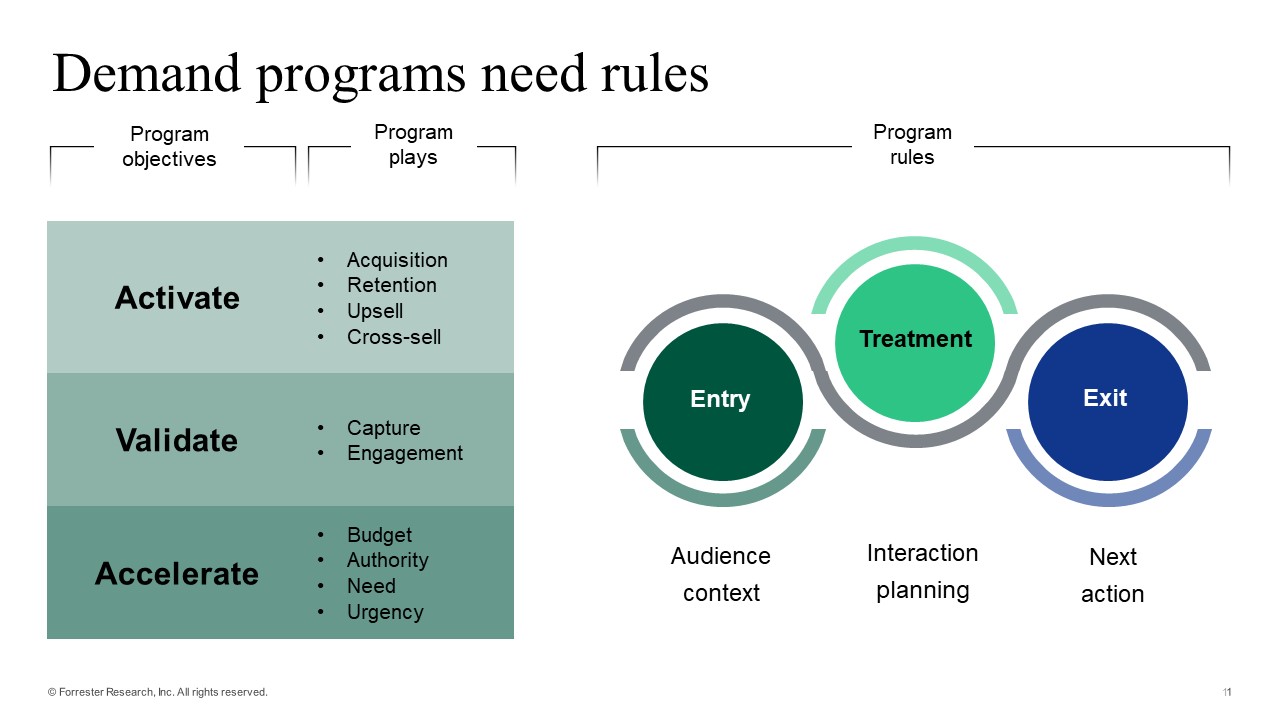Demand Programs — Using Rules To Design Program Flows
Demand marketers need a scalable and repeatable process to support buying group needs while in a demand program. Demand programs have program objectives with corresponding program plays to get and move opportunities with connected buying group members through the B2B Revenue Waterfall. Demand program plays are different types of programs to support demand program objectives of activate, validate, and accelerate.
So, how do I design the program plays and determine which ones are best? Who’s eligible for which play? And how do I know? This is where program rules help. Clearly defining and documenting the entry, treatment, and exit rules for each program play will reduce complexity, help increase program performance, and create a better and more relevant buyer experience.
Program rules outline criteria for audience context, interaction planning, and next best actions for individuals and buying groups.

Entry Rules Define Audience Eligibility
Entry rules outline the triggers that move people into a program. Entry rules leverage account, individual, and buying group criteria that provide the audience with context and eligibility.
- Account. Segment, account type, account tier, geography, industry, size, and other firmographic information
- Individual. Persona attributes — job role, function, buyer role, past behavior, intent, permission, and other demographic information
- Buying group. Collective intent, common solution of interest, collective content consumption, program interactions, collective engagement, past behavior, and opportunity stage
Treatment Rules Plan Interactions
Treatment rules describe the best way to engage buying group members. Treatment rules include message, preference, and tactics criteria.
- Message. Buying group members’ primary needs, using a conversational tone. Support the knowledge requirements of the entire buying group to progress the opportunity. The message and offer must include proof points that the buying group member can trust.
- Preference. The intensity and pace the buying group member prefers, including timing and types of communication via a preference center or historical, individual interaction data
- Tactics. The combination of a theme, asset play, and delivery mechanism. Treatment rules are designed to allow tactic selection flexibility to support the preference of the individual. Rules must also support a strategy around the ongoing collection of buying group engagement signals.
Exit Rules Determine The Next Action
Exit rules outline the next action criteria for individuals in a program. Exit rules include behavior, score, and routing.
- Behavior. Behaviors or buying indications are shown by an individual member in the buying group or any other member in the buying group. These buying indications are single actions or a set of actions that have been achieved, or not achieved, by an individual or buying group.
- Score. Thresholds are met by any member in the buying group or by the total buying group score. Since scoring can be calculated at the individual, account, or buying group level, any score can be used to evaluate score thresholds for exit rules.
- Routing. Once the criteria have been met via behavior or score, routing of the individual or buying group comes next. Routing of the individual or buying group can be as simple as waiting for a specific number of days, entering another program, going to a receiving function (revenue development rep, sales rep, customer success) for follow-up, or doing nothing.
Want to hear more? Join our colleagues for a North America Planning Assumptions 2022: B2B Marketing webinar where we’ll discuss more about demand program plays. Register here.
Related Forrester Content
- Demand Marketing Delivery Mechanisms: A Glossary
- The Delivery Mechanism Selection Framework
- Capture, Connect and Leverage Buying Group Signals in Demand Programs
- Buying Group Scoring 101: What to Score and Why
- Buying Group Service-Level Agreements 101: Defining What To Pass Between Revenue Engine Teams
